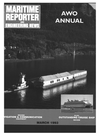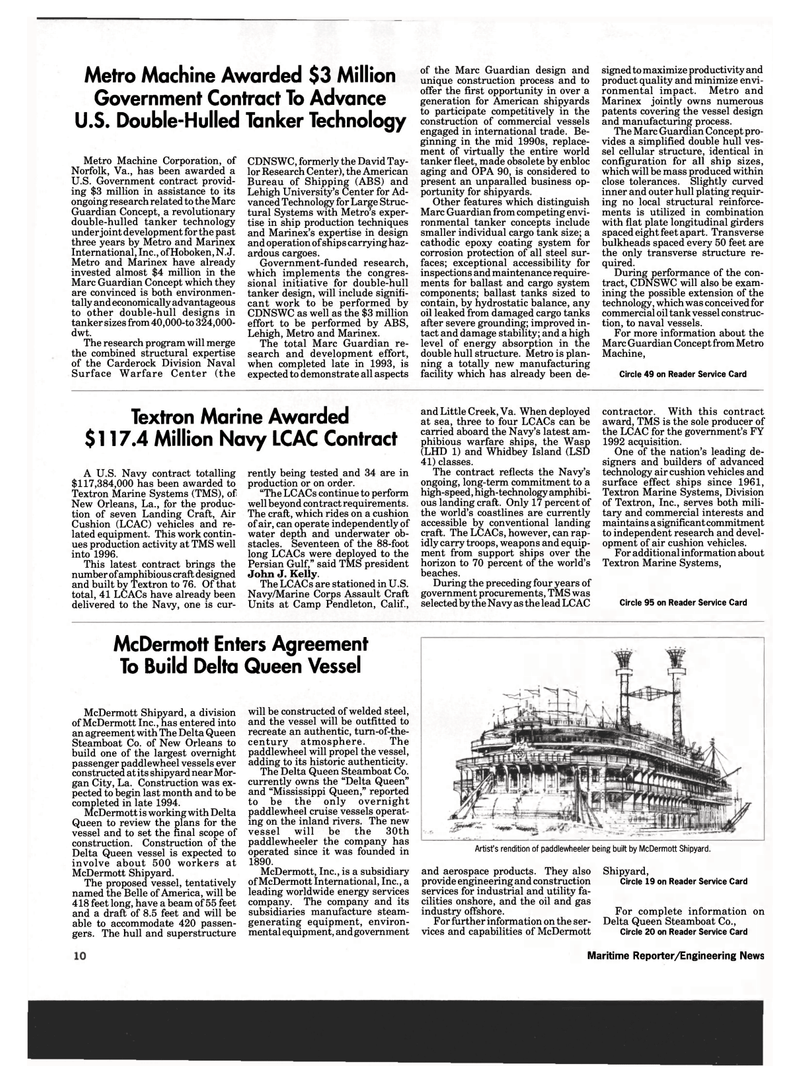
Page 8: of Maritime Reporter Magazine (March 1993)
Read this page in Pdf, Flash or Html5 edition of March 1993 Maritime Reporter Magazine
Metro Machine Awarded $3 Million
Government Contract To Advance
U.S. Double-Hulled Tanker Technology
Metro Machine Corporation, of
Norfolk, Va., has been awarded a
U.S. Government contract provid- ing $3 million in assistance to its ongoing research related to the Marc
Guardian Concept, a revolutionary double-hulled tanker technology under joint development for the past three years by Metro and Marinex
International, Inc., of Hoboken, N.J.
Metro and Marinex have already invested almost $4 million in the
Marc Guardian Concept which they are convinced is both environmen- tally and economically advantageous to other double-hull designs in tanker sizes from 40,000-to 324,000- dwt.
The research program will merge the combined structural expertise of the Carderock Division Naval
Surface Warfare Center (the
CDNSWC, formerly the David Tay- lor Research Center), the American
Bureau of Shipping (ABS) and
Lehigh University's Center for Ad- vanced Technology for Large Struc- tural Systems with Metro's exper- tise in ship production techniques and Marinex's expertise in design and operation of ships carrying haz- ardous cargoes.
Government-funded research, which implements the congres- sional initiative for double-hull tanker design, will include signifi- cant work to be performed by
CDNSWC as well as the $3 million effort to be performed by ABS,
Lehigh, Metro and Marinex.
The total Marc Guardian re- search and development effort, when completed late in 1993, is expected to demonstrate all aspects of the Marc Guardian design and unique construction process and to offer the first opportunity in over a generation for American shipyards to participate competitively in the construction of commercial vessels engaged in international trade. Be- ginning in the mid 1990s, replace- ment of virtually the entire world tanker fleet, made obsolete by enbloc aging and OPA 90, is considered to present an unparalled business op- portunity for shipyards.
Other features which distinguish
Marc Guardian from competing envi- ronmental tanker concepts include smaller individual cargo tank size; a cathodic epoxy coating system for corrosion protection of all steel sur- faces; exceptional accessibility for inspections and maintenance require- ments for ballast and cargo system components; ballast tanks sized to contain, by hydrostatic balance, any oil leaked from damaged cargo tanks after severe grounding; improved in- tact and damage stability; and a high level of energy absorption in the double hull structure. Metro is plan- ning a totally new manufacturing facility which has already been de- signed to maximize productivity and product quality and minimize envi- ronmental impact. Metro and
Marinex jointly owns numerous patents covering the vessel design and manufacturing process.
The Marc Guardian Concept pro- vides a simplified double hull ves- sel cellular structure, identical in configuration for all ship sizes, which will be mass produced within close tolerances. Slightly curved inner and outer hull plating requir- ing no local structural reinforce- ments is utilized in combination with flat plate longitudinal girders spaced eight feet apart. Transverse bulkheads spaced every 50 feet are the only transverse structure re- quired.
During performance of the con- tract, CDNSWC will also be exam- ining the possible extension of the technology, which was conceived for commercial oil tank vessel construc- tion, to naval vessels.
For more information about the
Marc Guardian Concept from Metro
Machine,
Circle 49 on Reader Service Card
Textron Marine Awarded $117.4 Million Navy LCAC Contract
A U.S. Navy contract totalling $117,384,000 has been awarded to
Textron Marine Systems (TMS), of
New Orleans, La., for the produc- tion of seven Landing Craft, Air
Cushion (LCAC) vehicles and re- lated equipment. This work contin- ues production activity at TMS well into 1996.
This latest contract brings the number of amphibious craft designed and built by Textron to 76. Of that total, 41 LCACs have already been delivered to the Navy, one is cur- rently being tested and 34 are in production or on order. "The LCACs continue to perform well beyond contract requirements.
The craft, which rides on a cushion of air, can operate independently of water depth and underwater ob- stacles. Seventeen of the 88-foot long LCACs were deployed to the
Persian Gulf," said TMS president
John J. Kelly.
The LCACs are stationed in U.S.
Navy/Marine Corps Assault Craft
Units at Camp Pendleton, Calif., and Little Creek, Va. When deployed at sea, three to four LCACs can be carried aboard the Navy's latest am- phibious warfare ships, the Wasp (LHD 1) and Whidbey Island (LSD 41) classes.
The contract reflects the Navy's ongoing, long-term commitment to a high-speed, high-technology amphibi- ous landing craft. Only 17 percent of the world's coastlines are currently accessible by conventional landing craft. The LCACs, however, can rap- idly carry troops, weapons and equip- ment from support ships over the horizon to 70 percent of the world's beaches.
During the preceding four years of government procurements, TMS was selected by the Navy as the lead LCAC contractor. With this contract award, TMS is the sole producer of the LCAC for the government's FY 1992 acquisition.
One of the nation's leading de- signers and builders of advanced technology air cushion vehicles and surface effect ships since 1961,
Textron Marine Systems, Division of Textron, Inc., serves both mili- tary and commercial interests and maintains a significant commitment to independent research and devel- opment of air cushion vehicles.
For additional information about
Textron Marine Systems,
Circle 95 on Reader Service Card
McDermott Enters Agreement
To Build Delta Queen Vessel
Artist's rendition of paddlewheeler being built by McDermott Shipyard.
McDermott Shipyard, a division of McDermott Inc., has entered into an agreement with The Delta Queen
Steamboat Co. of New Orleans to build one of the largest overnight passenger paddlewheel vessels ever constructed at its shipyard near Mor- gan City, La. Construction was ex- pected to begin last month and to be completed in late 1994.
McDermott is working with Delta
Queen to review the plans for the vessel and to set the final scope of construction. Construction of the
Delta Queen vessel is expected to involve about 500 workers at
McDermott Shipyard.
The proposed vessel, tentatively named the Belle of America, will be 418 feet long, have a beam of 55 feet and a draft of 8.5 feet and will be able to accommodate 420 passen- gers. The hull and superstructure will be constructed of welded steel, and the vessel will be outfitted to recreate an authentic, turn-of-the- century atmosphere. The paddlewheel will propel the vessel, adding to its historic authenticity.
The Delta Queen Steamboat Co. currently owns the "Delta Queen" and "Mississippi Queen," reported to be the only overnight paddlewheel cruise vessels operat- ing on the inland rivers. The new vessel will be the 30th paddlewheeler the company has operated since it was founded in 1890.
McDermott, Inc., is a subsidiary of McDermott International, Inc., a leading worldwide energy services company. The company and its subsidiaries manufacture steam- generating equipment, environ- mental equipment, and government and aerospace products. They also provide engineering and construction services for industrial and utility fa- cilities onshore, and the oil and gas industry offshore.
For further information on the ser- vices and capabilities of McDermott
Shipyard,
Circle 19 on Reader Service Card
For complete information on
Delta Queen Steamboat Co.,
Circle 20 on Reader Service Card 100 Maritime Reporter/Engineering News

 7
7

 9
9
